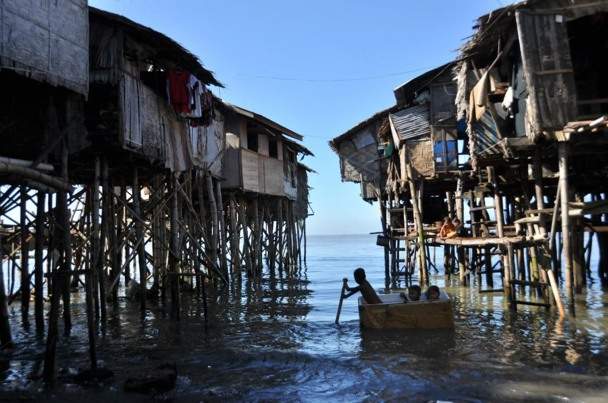Alfredo and Isabel Aquilizan: In-Habit: Project Another Country
Artists create a living, floating, migrant shantytown. From cardboard.
Overview
Sherman Contemporary Art Foundation has been taken over. Hanging from scaffolding is an enormous cardboard structure, a slum created by husband-and-wife team Alfredo and Isabel Aquilizan. The sheer scale of this installation is staggering. From the ceiling to the floor, the shantytown takes over the gallery with hundreds of tiny, modular cardboard elements tacked on and expanding like tumours. The houses expand in every direction and dimension into a floating, horizonless, living city. This is an abstracted version of a real place: a nomadic, seafaring indigenous people called the Badjao live in the Phillipines. A documentary tells us the Badjaos live in houses on stilts so their beds stay dry. The people and their houses are in a constant state of flux: Alfredo and Isabel are in fact from the Phillipines and have since moved to Australia. Their identity swims in a no-man's-land between the two countries.
Peeking out from cardboard windows are videos of Badjao children rapping and drumming (busking is their main source of income, and their sound recalls early M.I.A.). The concept is carried out to it’s maximum potential: miniature bamboo skewer ladders connect tiny apartments, there are tiny Badjao drums scattered around the place, and even the hooks that hold the headphones are made from tape and card. Audience members, especially kids, are provided with the means to create their own little cardboard structures which they take home or give to the gallery attendants to add on to the installation.
The artists' choice of second-hand cardboard as their main material is genius. It recalls the Depression-era ghettoes where vagrants made their makeshift homes. It's also metaphor for the slum's invisible inhabitants: the Badjao people have been discarded by the rest of society and relegated to the fringe between the land and the sea. The Aquizilans have visually distilled the essence of the migrant experience and ideas about refuge, displacement and poverty. Though it comes from a place of personal experience, In-Habit can't help but be deeply political.
Ducking and weaving to explore the massive shantytown, I realised how rare it is for artists to actually transform an entire gallery. The Aquilizans have morphed a cold, white cube into an entire new world that is exciting and treacherous and fun to navigate.
Many contemporary art projects employ the idea of “community engagement” as a token afterthought, a measure of lip service, when in reality, they just continue to relate to the same art-going minority. In-Habit is not like that. Though the project is in part aimed at children, it’s not for kids as such: it’s for everyone, and it shows that art at its most excellent can engage anyone, regardless of their art-world knowledge and familiarity.





